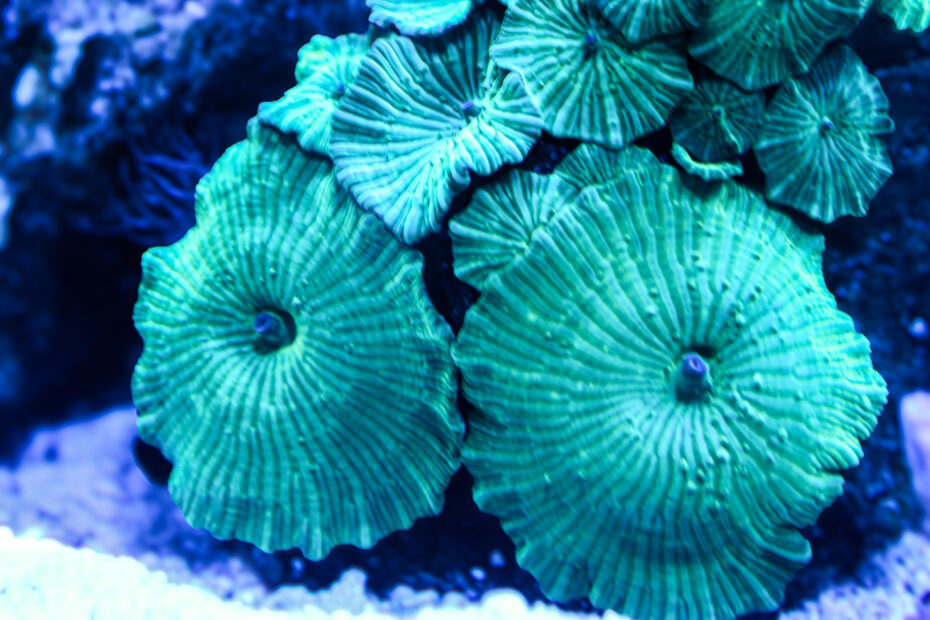Discosoma Coral (Mushroom Coral, Disc Anemone)
• Common Name: Mushroom Coral, Disc Anemone
• Scientific Name: Discosoma spp.
• Class: Anthozoa
• Origin: Indo-Pacific, Caribbean, Australia
• Category: Soft Coral
• Care Level: Beginner
• Temperament: Peaceful (but can spread aggressively)
• Lighting: Low to Medium (PAR 50-150)
• Flow: Low to Moderate (gentle, indirect flow)
• Placement: Bottom to Middle (best on rockwork or sandbed)
• Growth Rate: Fast
Overview:
Discosoma, commonly known as Mushroom Coral or Disc Anemones, are some of the hardiest and most beginner-friendly corals in the reef-keeping hobby. They are known for their vibrant colors, easy care, and ability to rapidly spread, making them an excellent choice for new reef keepers or those looking to create a colorful, low-maintenance coral garden.
Discosoma corals can tolerate a wide range of conditions, making them ideal for low-tech reef tanks, but they can become invasive if left unchecked.
Tank Requirements & Water Parameters:
Discosoma mushrooms are very forgiving, but they thrive in stable conditions:
• Temperature: 76-80°F (24-27°C)
• pH: 8.1-8.4
• Salinity: 1.024-1.026 SG
• Alkalinity: 7-10 dKH
• Calcium: 380-450 ppm
• Magnesium: 1250-1350 ppm
• Nitrate: 5-15 ppm (prefers moderate nutrients)
• Phosphate: 0.03-0.1 ppm
Unlike many stony corals, Discosoma prefers slightly elevated nutrients and can thrive in “dirty” tanks with higher nitrates.
Lighting Needs:
Discosoma corals prefer low to moderate lighting (PAR 50-150) and can thrive in shaded areas of the tank.
• Too much light can cause color fading or retraction.
• Under higher lighting, mushrooms may “bounce”, displaying unique textures.
Ideal placement is in lower-lit areas of the tank, but they will gradually adapt to brighter spots if moved slowly.
Flow Requirements:
• Low to moderate flow is best.
• Too much flow can cause mushrooms to detach and drift around the tank.
• They thrive in gentle, indirect water movement.
Feeding & Nutrition:
Discosoma mushrooms rely primarily on photosynthesis, but they can absorb dissolved nutrients from the water. While they do not require direct feeding, supplemental feeding can enhance growth and color:
• Ideal Foods:
• Phytoplankton
• Reef amino acids
• Powdered coral foods (e.g., Reef Roids)
Feeding 1-2 times per week can encourage faster growth and color intensity.
Placement & Aggression:
• Placement: Bottom to middle of the tank—great for rockwork or open sandbeds.
• Aggression: Peaceful, but they spread quickly and can overtake neighboring corals.
• Avoid placing them near sensitive SPS corals, as they can outcompete them over time.
Growth & Propagation:
Discosoma mushrooms grow very quickly, often spreading across rocks and forming dense colonies. They reproduce via:
1. Natural Division: They split into two or more mushrooms over time.
2. Pedal Laceration: Small pieces break off and regrow into new mushrooms.
3. Manual Fragging: Cutting a mushroom into sections, each regenerating into a full polyp.
Tip: To control their spread, place them on isolated rocks or create a “mushroom island” to prevent them from overtaking other corals.
Popular Color Morphs & Variations:
Discosoma mushrooms come in an array of colors, patterns, and textures. Some of the most sought-after varieties include:
• Superman Mushroom – Bright red with blue spots
• Blue Discosoma – Deep blue hues with iridescence
• Green Fluorescent Mushroom (GFM) – Intense neon green, glows under actinics
• Purple Discosoma – Deep purple tones with subtle speckles
• Red Discosoma – Rich, blood-red hues
• Spotted or “Ricordea-like” Discosoma – Unique spotted patterns
Challenges & Common Issues:
• Spreading too quickly: If left unchecked, Discosoma mushrooms can overgrow a reef tank and shade out other corals.
• Detaching from rockwork: Strong flow or stress can cause mushrooms to detach and float around the tank. They can be reattached using frag glue, rubber bands, or mesh.
• Color fading: Can occur if placed under excessive lighting or if nutrients are too low. Move to a lower-light area or adjust nutrient levels.
• Melting or shrinking: If parameters fluctuate too much, mushrooms may shrink or “melt.” Keeping stable conditions prevents this.
